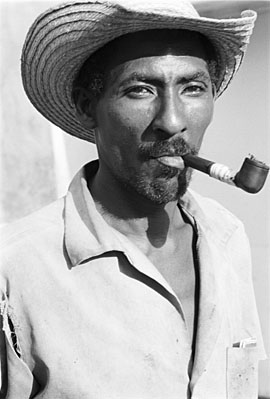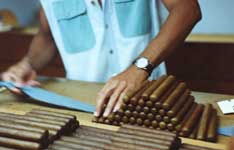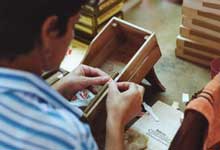The
town that time forgot:
An example of socialism
in Cuba's tobacco industry
by Daniela
Mohor
 |
|
photo
by Mimi Chakarova
|
The warm smell of tobacco
floats in the room. Wooden tables covered with piles of tobacco leaves
are lined up. Sitting at their desks like children in a classroom, more
than 100 Cubans hand roll some of the world's most sought after cigars:
Montecristo, Cohiba, Romeo y Julieta. As they work soft wrapper leaves
over rougher tobacco, they listen to a morning radio sitcom.
"The man's face is the face
of a dog," says a deep and manly voice. "It's a threatening face."
No one pays much attention.
Instead, workers chat among themselves. While they joke, even holler
across the room, their fast fingers effortlessly grab the brown leaves
and shape the cigars. Despite the daily production quota of more than
100 cigars per worker, the atmosphere is relaxed and friendly. Most
of the hand-rollers are young, have known each other since childhood,
and appear happy to be there. The opening of the factory has made their
life easier.
Inaugurated in January 2000
in the small town of Pilotos, about three hours southwest of Havana,
the Juan Casanueva factory, named for a local martyr of the revolution,
is the direct result of a local initiative and the latest expression
of the community's strong support for the revolution.
The factory became a reality
when a group of tobacco growers from the town's agricultural cooperative
made an uncommon move. They went to Fidel Castro and asked him to transform
the abandoned military base into a cigar factory. They had two purposes:
to create new job opportunities to keep young people in town, and to
serve the revolution. Castro liked both.
Pilotos' new factory is
one of 60 cigar operations that are playing an increasingly significant
role in the country's post-Soviet economy. In the early 1990s, with
the collapse of the USSR and its support of Cuba's economy, the island
sunk into a deep recession. In the span of three years the GDP shrunk
by 40% and the state could not feed its citizens. The crisis pushed
Castro's regime to ease market restrictions and introduce dollars into
the economy. The state too needed hard currency, and so it turned to
the sectors that generated the highest income in dollars: tourism and
export tobacco.
While the price of raw tobacco
is roughly 10 cents per pound, a box of Cuban cigars abroad sells for
as much as $200. The market is profitable, and Castro knows it: new
brands and new sizes of cigars at different price keep appearing and
every season new workers are incorporated in the industry.
For a factory at the cutting
edge of the economy, the Pilotos plant is also a throw back to the best
days of socialism. Everyone has a role to play in the production and
all laborers are equally important. Piñaldo Franco, the director
of Pilotos factory explains, "The country is a single entity, the factory
is a single entity and it has a single owner: Fidel Castro."
| "I
was born under a tobacco tree," jokes Orlando Acosta. "So
I know a bit about tobacco." |
Like many of Pilotos 5000
residents, Orlando Acosta, the factory's production supervisor take
prides in his lifetime of working in tobacco. He is a quiet but friendly
man with a soft voice and a brown moustache. At the factory, people
simply call him Rolando.
"I was born under a tobacco
tree," he jokes in the small storage room where raw material is handed
out to the rollers. "So I know a bit about tobacco."
On weekends, when he can
escape family duties, Rolando goes to the countryside where he still
has a vega, or tobacco field. There, he relaxes and "forgets about work."
Going from growing tobacco
at the local cooperative to managing an industrial factory was no small
task. Rolando and two other cofounders had to learn everything from
selecting and stemming tobacco leaves to hand-rolling cigars and quality
control. For 13 months he attended class in Havana and visited other
factories in Pinar del Rio, the traditional tobacco region where Pilotos
is situated.
By June 1999, they were
ready to open a hand-rolling school in the factory and receive the first
group of workers: 73 people took the first class, including Rolando's
wife. Since then, dozens of new recruits have been selected and trained
every season, contributing to the production's steady increase. Last
year laborers rolled 1.4 million cigars, surpassing their goal by more
than 200, 000 pieces. This year, the factory hopes its 206 workers and
66 students will make more than 2.4 million cigars.
Underlying such efficiency
is the state's new incentive policy. With the crisis, the government
dug up an agricultural law from the late 1980s that permitted independent
tobacco farmers to use idle cropland to grow tobacco.
The state provided other
incentives as well. The government still sets the price of tobacco and
furnishes fertilizer and agricultural supplies, but now farmers are
paid according to their productivity. The more they grow, the more they
earn, and part of their income is in dollars. The same incentives apply
to factories. Workers receive six percent of their wage in dollars and
extra money for each cigar they make above their daily quota. At the
Pilotos factory, some workers have doubled their $16 monthly wage.
All over Cuba, the incentives
have worked: between 1996 and 2000 the number of cigars exported rose
from 70 million to 118 million. And this year, Habanos S.A., the distribution
company for Cuban cigars, plans to ship 150 million.
The significance of tobacco
in Cuba, however, goes beyond its potential to save the island from
the dollar crisis. Tobacco is to Cuba what scotch is to Scotland.
 |
|
photos
by Daniela Mohor
Men roll cigars
at the Pilotos plant.
|
 |
"Talking about tobacco is
talking about the national cultural identity," said Zoe Nocedo, the
director of the Museum of Tobacco in downtown Havana. "It is not only
a fundamental product for the economy, but a product that helped the
development of the history of Cuban culture."
When Cubans don't want someone
to expand for hours on a topic they say: "Don't tell me the whole history
of tobacco." And they have good reason.
By the time Christopher
Columbus discovered Cuba in 1492, the Indian natives had already organized
all their rituals around the tobacco tree or "cohiba." They smoked to
communicate with divinities and they used the plant as medicine to cure
skin diseases and cuts. Columbus' crew smoked for enjoyment and it didn't
take long for them to send the leaf home.
After unsuccessfully trying
to prohibit tobacco imports in 1717, the Spanish Crown instead decided
to establish a monopoly on tobacco's cultivation and comercialization.
A century later, Cuban rebellions and problems of mismanagement led
to the end of the monopoly and the island developed its own tobacco.
With the creation of the
island's first cigar factories, the tobacco industry took center stage
in Cuban history. To entertain the rollers, tobacco barons hired readers,
who read news and literature from around the world- a tradition that
gave workers the reputation of being the world's most educated.
It didn't take long before
they started organizing and progressively acquired political power.
They participated in all major strikes affecting the country, supported
José Martí's fight for independence and later Castro's
revolution. Nowadays, the reader's fare is limited to Granma, the national
paper, and romance novels.
Back
to stories page



